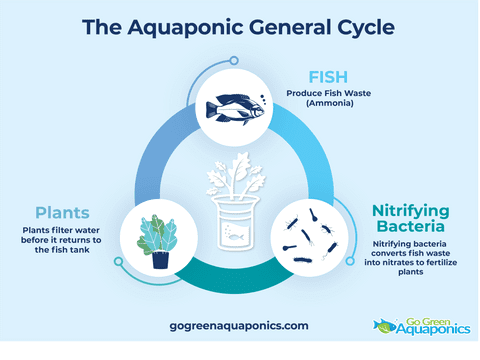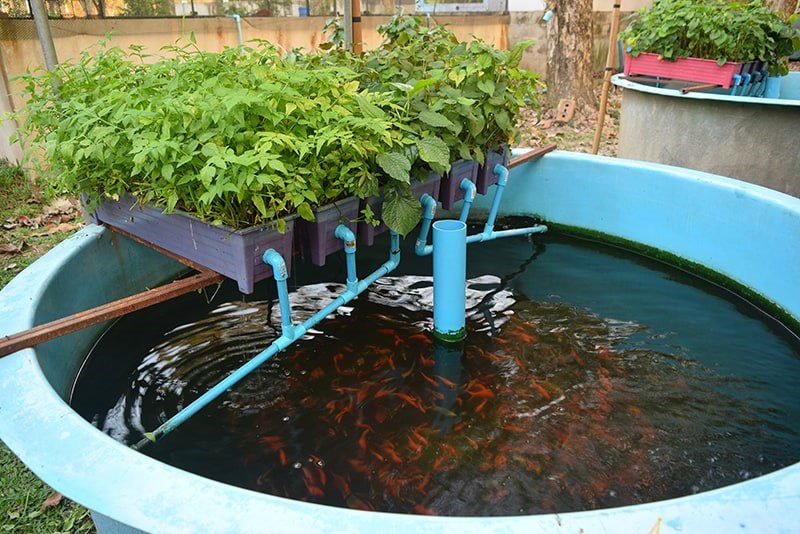The Aquaponics system is a method of growing food that combines aquaculture (the practice of raising fish) and hydroponic (a soilless way of growing plants). Through the combination of these two growing methods, aquaponics offer a way to grow food that is resource-efficient, environmentally friendly, and yields high-quality produce.

How it works
In aquaponics, the waste produced by fish is converted by the beneficial bacteria into nutrients that plants absorb. The plants, in turn, filter the water for the fish. This creates a closed-loop system that uses 90% less water than traditional agriculture and can produce fish and vegetables in a small space all year round.
Aquaponics relies on a mutually beneficial relationship between fish and plants. This process involves fish excreting waste that is broken down into vital nutrients that the plants use for nourishment. The plants, in return, act as natural filters, thus purifying the water and allowing the fish to thrive in a clean and healthy environment.
Advantages of Aquaponics
Aquaponics continues to gain popularity among farmers, gardeners, and sustainable food enthusiasts because of the many benefits it provides.
The following are some benefits of aquaponics.
Aquaponics uses less water than traditional growing method and doesn’t rely on harmful chemicals or pesticides to produce fresh and healthy harvests of fish, fruits, herbs, and vegetables.
An Aquaponics system can produce a high yield of both fish and plants in a small space all year round (if done in an indoor setup). Plants grow faster in aquaponics systems because of their constant access to nutrient-rich water.
Fresh, Nutritious Produce grown in aAquaponic system can grow a variety of fresh produce that is high in nutrients and free from harmful chemicals. Because the plants grown in aquaponics are free from fertilizers and other chemicals. Aquaponics use up to 90% less water than traditional agriculture because the water is recycled through the system.
Once fully established and working, aquaponic systems are easy to maintain and require less work than traditional agriculture. Aquaponics can be an excellent tool for teaching children and adults about sustainable agriculture and science that is related to biology, chemistry, and physics.
Important factors to consider
Choose an aquaponics system that you want to implement. You can choose between media-based systems, raft systems, NFT systems, or a combination of these systems.
Decide what are the goals and purpose of your aquaponics system?
What is the purpose of your aquaponics system? What plants or fish are you planning to grow and raise? Are you going to eat your fish? These questions should be given thought to plan your system correctly and know what method will meet your goals and purposes.
The Environment
Humidity in an aquaponics system, with water flow being constant, take in consideration your space’s natural evaporation and increased moisture. The fish tank or aquarium can leak. Therefore, the area where you want to create your system is an area that can get wet.
Plants need light to grow. All plants require sunlight for photosynthesis, which converts light, oxygen, and water into carbohydrates (energy). Plants need this energy to produce, bear fruit, and bloom.
Location
Here are some key considerations when choosing a location for your aquaponic system. Plants require enough light to grow, so choose a location where natural light or sunshine is accessible. Choose a location where the temperature can easily be regulated. Consider installing a heater or air conditioner to maintain a consistent temperature.
Your aquaponic system will require a constant water supply, so choose a location near a reliable water source. Also, ensure that your location has adequate drainage to prevent water from accumulating around the system.
- An aquaponic system will require an electrical outlet to power the water and air pumps. So choose a location near an outlet or consider using an extension cord to reach a nearby outlet. Proper ventilation is vital to prevent the buildup of humidity and to ensure that there is adequate airflow for the plants and fish.
Various suppliers and training institutions can help with the nitty-gritty of starting you off with auaponics so, with good management, your system takes off well!

